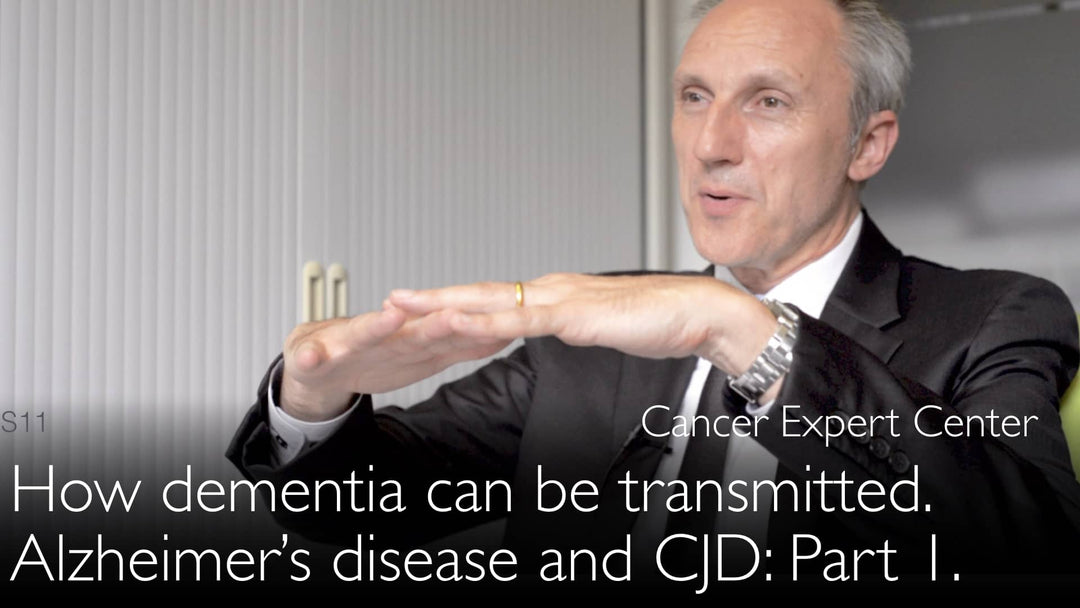Leading expert in neurodegenerative diseases, Dr. Sebastian Brandner, MD, explains the striking similarities between Alzheimer's disease and Creutzfeldt-Jakob disease (CJD), including their spontaneous development in 95% of cases and potential transmission through medical procedures involving brain tissue. The neuropathologist discusses how misfolded proteins can cause vascular complications and disease progression without traditional infectious agents.
Protein Misfolding Diseases: Comparing Alzheimer's and Creutzfeldt-Jakob Disease Mechanisms
Jump To Section
- Spontaneous Development in Neurodegenerative Diseases
- Disease Transmission Risks Through Medical Procedures
- Protein Deposition Effects on Brain Tissue
- Vascular Complications in Protein Misfolding Disorders
- Non-Infectious Disease Mechanisms
- Research Implications for Neurodegenerative Conditions
- Full Transcript
Spontaneous Development in Neurodegenerative Diseases
Dr. Sebastian Brandner, MD, emphasizes that both Alzheimer's disease and Creutzfeldt-Jakob disease (CJD) predominantly occur spontaneously, with genetic factors playing a minor role. "The vast majority, 95% of Alzheimer's disease cases are spontaneous. 95% of CJD cases are spontaneous," notes the neuropathology expert. This striking similarity between two distinct neurodegenerative conditions suggests common underlying mechanisms in protein misfolding disorders.
Disease Transmission Risks Through Medical Procedures
Dr. Sebastian Brandner, MD, explains that while these diseases arise spontaneously, they can potentially be transmitted through medical procedures involving brain tissue. "Alzheimer's disease and Creutzfeldt-Jakob disease could be transmitted via medical procedures where brain tissue is transmitted in some way," states Dr. Sebastian Brandner, MD. The exact transmission risk remains unknown, requiring further research to understand the frequency and conditions that might facilitate this rare occurrence.
Protein Deposition Effects on Brain Tissue
The transmission mechanism involves misfolded proteins rather than traditional infectious agents. Dr. Brandner clarifies, "It's not that we can transmit Alzheimer's disease. We can transmit the protein that then deposits and amplifies in the recipient brain." These abnormal proteins initiate a cascade of pathological changes, similar to prion diseases but with distinct clinical manifestations.
Vascular Complications in Protein Misfolding Disorders
Dr. Sebastian Brandner, MD, describes how these misfolded proteins can cause significant vascular damage in the brain. "The protein can cause problems in the blood vessels. Blood vessels in the brain become more brittle and start bleeding," explains Dr. Sebastian Brandner, MD. This condition, known as cerebral amyloid angiopathy, represents a distinct disease pathway that can affect younger patients following accidental transmission.
Non-Infectious Disease Mechanisms
Both Alzheimer's and CJD challenge traditional concepts of infectious disease. "These diseases are not bacterial and not viral," notes Dr. Brandner. Instead, they result from protein misfolding that "can precipitate intrinsic changes in the brain." This novel disease mechanism has transformed our understanding of neurodegenerative conditions and their potential transmission pathways.
Research Implications for Neurodegenerative Conditions
The parallels between Alzheimer's and CJD identified by Dr. Sebastian Brandner, MD, suggest new research directions for understanding protein misfolding disorders. The potential for iatrogenic transmission, though rare, highlights the need for careful handling of neurological tissues in medical settings. These findings may lead to improved safety protocols and novel therapeutic approaches targeting protein misfolding processes.
Full Transcript
Dr. Anton Titov, MD: Let’s also talk about Alzheimer's disease. There is a genetic influence, but it can also arise spontaneously. The vast majority—95% of Alzheimer’s disease cases—are spontaneous. Similarly, 95% of Creutzfeldt-Jakob disease (CJD) cases are spontaneous. But once the disease occurs, it can be transmitted via biological material.
Dr. Sebastian Brandner, MD: Yes, that's correct! I would say very clearly, Alzheimer’s disease and Creutzfeldt-Jakob disease could be transmitted via medical procedures—procedures where brain tissue is transmitted in some way. We don't yet know how risky that is. We don’t know how common it is, or whether it's easy or difficult.
Dr. Sebastian Brandner, MD: We should also clarify: it’s not that we can transmit Alzheimer's disease itself. We can transmit the protein that then deposits and amplifies in the recipient brain. It was established that this protein can cause problems in the blood vessels. Blood vessels in the brain become more brittle and may start bleeding. We have seen a few examples where transmission without prion disease was also possible.
Dr. Sebastian Brandner, MD: That leads young patients to the potential development of these vascular problems, similar to Alzheimer’s disease. We call it cerebral amyloid angiopathy. This is a whole different concept of disease.
Dr. Anton Titov, MD: Yes, that's correct! It's amazing—these diseases are not bacterial and not viral. Alzheimer’s disease and Creutzfeldt-Jakob disease are caused by a protein that can precipitate intrinsic changes in the brain.







